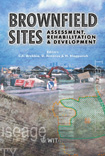Identification Of Subsurface Environmental Barriers And Brownfield Development
Price
Free (open access)
Transaction
Volume
55
Pages
Published
2002
Size
360 kb
Paper DOI
10.2495/BF020281
Copyright
WIT Press
Author(s)
K. Schejbalová & M. Vacek
Abstract
Identification of subsurface environmental barriers and brownfield development K. Schejbalova1 & M. Vacek1 1KAP, spol. s r.o., Czech Republic Abstract Restrictions and risks resulting from subsurface environmental aspects has become a significant part of the documentation during the preparatory phase of brownfield development. Brownfield foundation conditions, soil, soil gas and ground water contamination, contamination of building constructions and wastes disposed on site and other site-specific subsurface environmental barriers determine the future commercial success of the brownfield development. Developers should acknowledge these aspects during the early stages of the brownfield decision-making process, since these may impact on technical design, costs and time schedule of the investor’s intention. A step-by-step approach has become a normal procedure for the site assessment to identify subsurface environmental barriers. Application of the step-by-step approach is considered to be the most efficient for sites characterised by a long - term industrial operational history. It is proposed to apply the step-by-step approach divided into: Phase I- Review of present level of knowledge, identification of uncertainties involved; Phase 11- Site investigations; and Phase 111- Risk assessment, feasibility and cost- benefit study. The identification requires significant effort in terms of human resources, time, technical sources and costs. Results and outputs of the process can profoundly change the idea of future brownfield economical capacities, whch may even require their conversion. Therefore, it’s the author’s opinion that it would be highly practical to prepare a \“Road map” to enhance understanding of subsurface environmental barriers identification and management, similar to that prepared by US EPA.
Keywords




